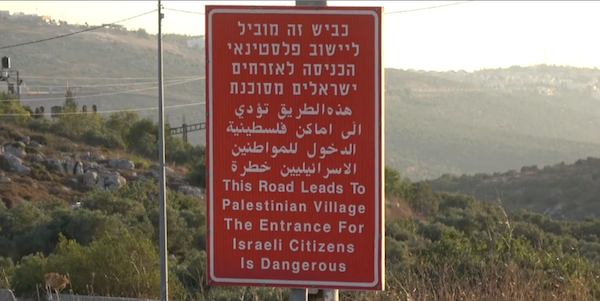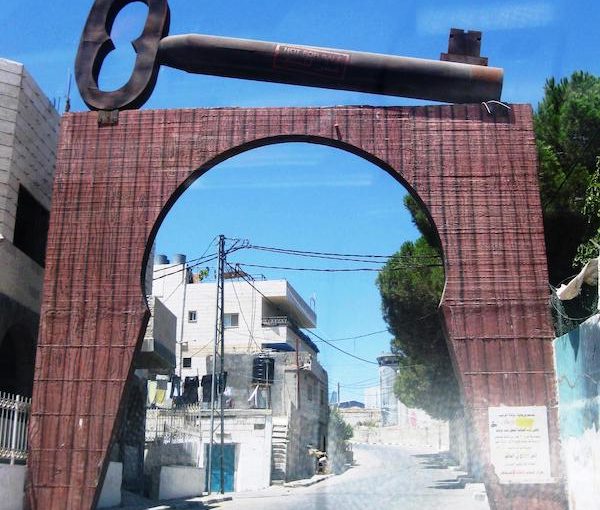According to one tour guide, an hour spent walking around the Aida Refugee Camp in Bethlehem and talking to the residents there is the best way to gain an understanding of the complex conflict that has caused so much suffering. (photo from Gil Zohar)
The throngs of foreign journalists parachuted into Israel to cover the judicial reform debacle – and the many more correspondents based here on a semi-permanent basis – do a poor job explaining basic facts of life in the Jewish state. A case in point is the West Bank.
Most English-speaking tourists I encounter as a licensed tour guide/journalist are woefully ignorant about the legal status and history of the territory Israel captured from the Hashemite Kingdom of Jordan in the June 1967 Six Day War. The term West Bank is a neologism King Abdullah invented in 1948, when his Arab Legion crossed the Jordan River from the east bank to occupy the area known in Mandatory Palestine as Judea and Samaria.
Apart from those traveling with companies like Abraham Tours, which offers a dual narrative tour of Hebron, or Green Olive Tours, which also promotes travel to the Palestinian Authority provisional capital Ramallah and other key Palestinian cities, most tourists avoid the Area A cities of Bethlehem, Ramallah, Nablus, Jenin, Tulkarm, Qalqilya and Hebron. The latter city, divided into PA-ruled H1 and IDF-controlled H2, is the only city in the West Bank with both Jewish and Palestinian residents.
Car rental companies like Hertz or Shlomo Sixt don’t offer insurance to visit Area A. The exception is Middle East Car Rental, located in East Jerusalem’s Wadi Joz neighbourhood, which provides twin insurance policies for those PA-controlled Area A cities, Israel-ruled areas B and C, and the pre-1967 remainder of the country.
What, then, are areas A, B and C? And what should a tourist know about visiting them?
First, the West Bank is safe for tourists – mostly. On March 18, two German nationals were surrounded by angry youths in Nablus, who slashed the tires of the tourists’ Israeli rental car. Notwithstanding that the two knew their car insurance was void in Area A, the pair – who were mistaken for Jewish settlers – drove to the city to enjoy Turkish coffee and the local goat cheese and rosewater pastry delicacy called knafeh nablusiyya. They were rescued by an Arab-Israeli who himself was shopping in Nablus in violation of the Israeli law barring its citizens from visiting Area A.
Looming trilingual signs painted red warn Israelis that entering Area A is dangerous. Nonetheless, hundreds of thousands of Israelis from Nazareth and elsewhere in the Galilee routinely shop in Jenin, where prices for food and vegetables are strikingly lower than in Israel, and where the 17% value-added tax is not paid.
Similarly, some Jerusalem Israelis illegally buy granite and marble products and furniture from factories in nearby Bethlehem, thus saving the 17% VAT. Trucks with yellow Israel licence plates, rather than the green and white ones used in the PA, routinely pass through the Israel Defence Forces roadblocks that ring the West Bank. These soldiers are not customs officers, so they don’t inspect waybills from those trucks, whose bilingual drivers have tuned their radio to Hebrew stations to blend in should they be stopped.
Apart from the aforementioned signs, nothing prevents anyone from driving into Area A. Under the bilateral Oslo Accords signed by Israel and the Palestine Liberation Organization in Washington, D.C., in 1993, Israel divided the West Bank into Areas A, B and C, and withdrew from the first. Area A is mostly composed of non-contiguous municipalities and villages, and Israel’s roads and bypass highways gerrymander around Area A cities.

Areas B and C are under the control of the Coordinator of Government Activities in the Territories (COGAT), a unit in Israel’s Ministry of Defence that coordinates civilian issues between the Israeli government, the IDF, international aid and nongovernmental organizations, diplomats, and the PA. Following the Oslo Accords, COGAT replaced the defunct Civil Administration, which had governed the West Bank and the Gaza Strip between 1981 and 1994. (Israel unilaterally quit Gaza in 2005.)
Returning from Area A to Israel can be trickier. The main difficulty is not the 800-kilometre-long incomplete wall and fence that partially encircles the West Bank. For example, while Palestinians with the correct documents and biometric ID card are required to pass through the Qalandiya checkpoint between Ramallah and Jerusalem, five kilometres to the east is the Hizma checkpoint used by Israelis living in the West Bank. Under normal security procedures, cars with yellow licence plates simply drive past the IDF troops. Bored-looking soldiers wave drivers through. Mostly, cars just slow down for perfunctory profiling.
But how does a scofflaw who scarfed hummus at Bandali in Ramallah’s Lower City get back to Jerusalem? Ditto for Rukab’s Ice Cream in the city centre, which has been dishing up its unique, stretchy gelato since 1941? Or the Vanilla café, renowned for its divine cakes? Having had a culinary respite from the Israeli-Palestinian conflict, one hails a cab and asks to be taken to the Rami Levy supermarket in Geva Benyamin, east of Ramallah. The driver – wink, wink – will drop you off on Route 60 at a slight distance from the settlement’s gate, which is guarded by an armed security officer. Should the guard ask you where you are coming from, the response “From Route 60” will be sufficiently vague that he will allow you past the barrier. There, at the bus stop, one waits for the bulletproof bus that drives back to Jerusalem through Hizma. No ID documents are checked.
Similarly, no documents are required for the 25-minute ride on Bus 231 from Jerusalem’s Damascus Gate Bus Station to central Bethlehem via Beit Jala. Like traveling from Ramallah back to Jerusalem, the return from Bethlehem requires some fudging of the truth. Bus passengers disembark at the checkpoint on Route 60 between Beit Jala and Jerusalem. Some Israeli citizens holding a foreign passport pretend to be tourists. When asked for the visa they received at Ben-Gurion Airport (which is issued on a sheet of paper rather than stamped in one’s passport), they play the “stupid card,” claiming they don’t have it. The guards may scowl but routinely let the faux-tourists re-board the bus rather than create ill-will.
Israel’s porous approach to security similarly applies on the West Bank’s highways. Today, all the permanent army roadblocks that once cut up the West Bank have been removed, allowing freedom of movement. “Z,” an intrepid tour guide who routinely takes tourists to all three sectors in the West Bank, points out where the decommissioned IDF posts once stood.
Jeff L., a lawyer from Los Angeles who volunteered with the Israeli army’s Sar-El program, recently went with Z on a day-long tour across the northern West Bank, including Nabi Musa (a shrine Muslims revere as the mausoleum of Moses), the oasis of ‘Ain Mabu’a, the all-Christian village of Taybe (with its renowned brewery), the all-Muslim village of Turmus Ayya, and the model city of Rawabi. Rawabi and Taybe are in Area A.
Stuck outside Ramallah in an L.A.-style traffic jam in the late afternoon, the two abandoned their plan to pose for a selfie outside Yasser Arafat’s tomb in the Muqata government compound.
In an email, Jeff wrote, “It was an awesome day. I will do my best to become an ambassador for peace.
“My day in the West Bank began at Wadi Qelt / Nahal Prat. The beautiful nature reserve was full of blooming wildflowers. Muslim women and their families from Hebron were enjoying the rushing water and lush surroundings. We were greeted warmly by all with big smiles.
“Visiting Taybe, Tarmus Ayya and Rawabi, again, everywhere we went we were warmly greeted. Fortunately, Z speaks Arabic and was able to communicate with everyone we met. My impression of the day in the West Bank was one filled with hope for the future.
“There was a genuine interest in everyone we met to talk and to make us feel welcome.
“All the people we met who live in the West Bank want the same peace and prosperity for their families as we [Jews] do.”
Z – who has a permit from the Israel Ministry of Tourism to enter Bethlehem and Jericho – has never encountered a problem in Area A or elsewhere in the West Bank. During the pandemic, he was stopped by a PA policeman en route to the Mar Saba monastery east of Bethlehem. The officer, who was carrying an AK-47, didn’t have an issue with a car full of tourists in a vehicle with yellow licence plates driving in Area A, but instructed them to return to Jerusalem because of the threat of COVID.
Should tourists to Israel also visit the West Bank and Area A?
Z insists that an hour spent walking around the Aida Refugee Camp in Bethlehem and talking to the residents there is the best way to gain an understanding of the complex conflict that has caused so much suffering. Moreover, tourist sites like Hisham’s Palace in Jericho or Jacob’s Well in Nablus, where Jesus is said to have chatted with a Samaritan woman, are all exceedingly interesting and photogenic. But Z recommends going with a seasoned tour guide, lest you end up like the two German tourists who were attacked going to Nablus’s al-Aqsa pastry shop.
Gil Zohar is a writer and tour guide in Jerusalem.

